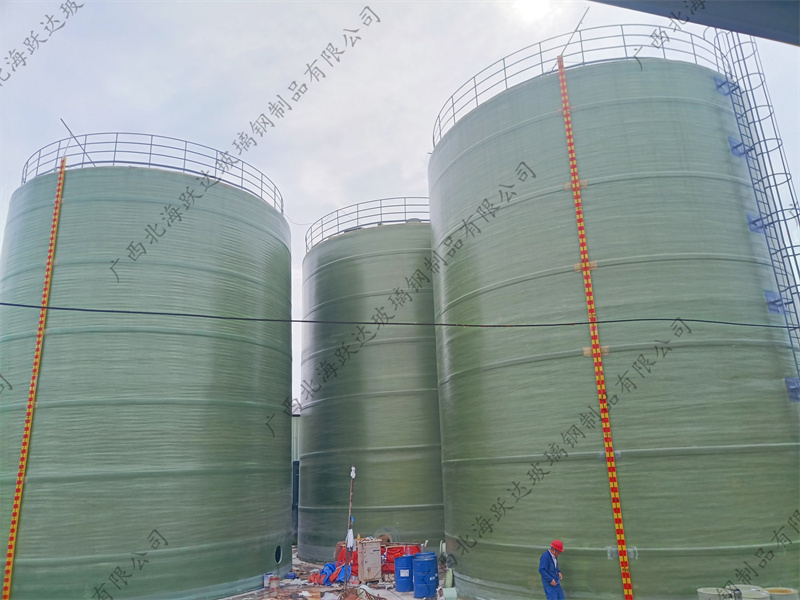Hotline:15078906688
E-mail:282911489@qq.com
- All
- Product Management
- News
- Introduction
- Enterprise outlets
- FAQ
- Enterprise Video
- Enterprise Atlas
Hotline:
Blog
BEIHAI YUEDA FRP PRODUCTS
Precautions for Fiberglass Reinforced Plastic (FRP) Hydrochloric Acid Tanks
Release time:
2024/09/30
The fiberglass hydrochloric acid storage tank is a special tank for holding hydrochloric acid, which can be made of plastic or fiberglass. The plastic hydrochloric acid storage tanks are usually sold in small barrels, while the fiberglass tanks are generally designed for long-term storage. Below are some precautions for installing hydrochloric acid tanks.

The fiberglass hydrochloric acid storage tank is a special tank for holding hydrochloric acid, which can be made of plastic or fiberglass. The plastic hydrochloric acid storage tanks are usually sold in small barrels, while the fiberglass tanks are generally designed for long-term storage. Below are some precautions for installing hydrochloric acid tanks.
1. The fiberglass hydrochloric acid tank should be placed on a base made of cement bricks. The height of the base is generally half the height of the tank. The base is usually constructed using on-site stacking methods.
2. When the inlet of the fiberglass hydrochloric acid tank is high above the bottom of the tank, the inlet should be bent towards the tank wall to allow the incoming liquid to flow down along the wall, reducing the impact on the bottom. If the liquid level in the hydrochloric acid storage tank cannot be controlled, an overflow port should be installed on the tank to prevent liquid overflow, which could cause unnecessary harm.
3. When the inlet of the fiberglass hydrochloric acid tank is high above the bottom of the tank, the inlet should be bent towards the tank wall to allow the incoming liquid to flow down along the wall, reducing the impact on the bottom. If the liquid level in the hydrochloric acid storage tank cannot be controlled, an overflow port should be installed on the tank to prevent liquid overflow, which could cause unnecessary harm. When the inflow and outflow of the hydrochloric acid storage tank are large, appropriate exhaust holes should be installed. When changing the liquid being stored, it is important to understand whether the anti-corrosion tank is suitable for the liquid being stored.
4Due to the fact that some hydrochloric acid tanks have all-plastic flanges that are softer than steel plates, care should be taken to reinforce them when connecting to other flanges. The flanges supplied by our company are generally tightened at the factory, but may become loose during transportation and handling. Users should check the sealing performance of the anti-corrosion tank before use, and can add liquid to observe for leaks. It is best to test for leaks with water when storing chemical liquids in the hydrochloric acid tank to prevent losses.
Beihai Yueda FRP Products
COOKIES
Our website uses cookies and similar technologies to personalize the advertising shown to you and to help you get the best experience on our website. For more information, see our Privacy & Cookie Policy
COOKIES
Our website uses cookies and similar technologies to personalize the advertising shown to you and to help you get the best experience on our website. For more information, see our Privacy & Cookie Policy
These cookies are necessary for basic functions such as payment. Standard cookies cannot be turned off and do not store any of your information.
These cookies collect information, such as how many people are using our site or which pages are popular, to help us improve the customer experience. Turning these cookies off will mean we can't collect information to improve your experience.
These cookies enable the website to provide enhanced functionality and personalization. They may be set by us or by third-party providers whose services we have added to our pages. If you do not allow these cookies, some or all of these services may not function properly.
These cookies help us understand what you are interested in so that we can show you relevant advertising on other websites. Turning these cookies off will mean we are unable to show you any personalized advertising.

WeChat Public Number

Mobile website
Contact Us
Telephone:0779-2096111
Mailbox:282911489@qq.com
Address: 200 m north of the intersection of Hong Kong Road and Southwest Avenue in Beihai Industrial Park
©2023 Guangxi Beihai Yueda FRP Products Co., Ltd. All rights reservedSEO Tags







